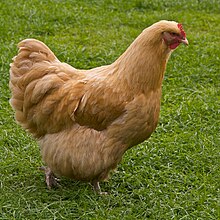Orpington chicken
 A buff hen | |
| Country of origin | United Kingdom |
|---|---|
| Standard | |
| Use | showing |
| Traits | |
| Weight | |
| Skin colour | white |
| Egg colour | brown[2]: 228 |
| Comb type | medium single |
| Classification | |
| APA | English[3] |
| PCGB | soft feather: heavy[4] |
| |
The Orpington is a British breed of chicken. It was bred in the late nineteenth century by William Cook of Orpington, at that time in Kent in south-east England.[5]: 115 It was intended to be a dual-purpose breed, to be reared both for eggs and for meat, but soon became exclusively a show bird.[6][7] The Australorp of Australia derives from it.
History
[edit]The original Black Orpington was bred by William Cook in the 1880s in Orpington, which at that time was in Kent in south-east England.[5]: 115 He crossed Minorcas, Langshans and Plymouth Rocks to create a new hybrid bird. It was bred as a dual-purpose utility chicken, to be reared both for eggs and for meat; Cook chose black as a colour that would not show the soot and grime of London.[8]: 158 He was also the breeder of the Orpington Duck.[9]: 74
Black Orpingtons were exhibited at the Dairy Show in Islington in 1886, and also at shows in The Crystal Palace in Sydenham and in Birmingham. A separate show class was created for them in 1888.[10] From the early 1890s, large black Langshan–Cochin crosses were being exhibited and marketed as Orpingtons by Joseph Partington of Lytham in Lancashire and other breeders. These birds were unrelated to Cook's and although similar in appearance, did not have the same productive qualities.[11]: 247 [12]: 159 They were larger and had fuller feathering, and won numerous prizes at poultry shows; some were sold for very large sums.[12]: 159 A bantam buff Orpington was bred by Herman Kuhn in Germany in about 1900.[8]: 254
A breed society, the Orpington Club, was started in 1887. Several clubs were later formed for individual colour varieties; in 1975 many of these merged with the Orpington Bantam Club to form a second Orpington Club.[10]
The Australorp of Australia derives from – and resembles – Cook's original black stock, and preserves its productive qualities.[12]: 169
In the United States four colours – black, blue, buff and white – were added to the Standard of Perfection of the American Poultry Association in 1960.[3]
Characteristics
[edit]Seven colour varieties are recognised by the Poultry Club of Great Britain: black, blue, buff, cuckoo, jubilee, spangled and white.[11]: 248 The Entente Européenne recognises thirteen colours, and lists two more.[13] In the bantam, only the colours black, blue, buff and white are recognised by the Poultry Club of Great Britain,[11]: 249 but several others have been bred;[8]: 254 the Entente Européenne lists sixteen, of which eleven are recognised.[13] The British poultry geneticist W.C. Carefoot bred a chocolate-coloured bantam in the 1990s, a colour previously unknown in chickens, caused by a sex-linked recessive gene.[12]: 163 [14] The bantam rarely takes flight.[8]: 254
Body weights for large fowl are approximately 3–3.5 kg for hens and 4–4.5 kg for cocks;[15]: 66 average weights for bantams are 1.3 kg and 1.5 kg respectively.[16]: 67
Use
[edit]Orpington hens lay about 180 light brown eggs per year, with an average weight of 53 g;[8]: 158 [15]: 66 bantam hens lay about 110 eggs, with a weight of some 40 g.[16]: 67
It was said that at one time Orpingtons were capable of laying as many as 340[5]: 115 eggs per year. The decline in production was due to breeders selecting for looks over utility.[17]: 98
-
Buff cock
-
White, barred and gold-laced hens
-
Lavender cock
-
Black bantam hen
References
[edit]- ^ a b The Orpington Breed Standards. The Orpington Club. Archived 20 March 2013.
- ^ Victoria Roberts (2008). British poultry standards: complete specifications and judging points of all standardized breeds and varieties of poultry as compiled by the specialist breed clubs and recognised by the Poultry Club of Great Britain. Oxford: Blackwell. ISBN 9781405156424.
- ^ a b APA Recognized Breeds and Varieties: As of January 1, 2012. American Poultry Association. Archived 4 November 2017.
- ^ Breed Classification. Poultry Club of Great Britain. Archived 12 June 2018.
- ^ a b c Pam Percy (2006). The Field Guide to Chickens. St. Paul, Minnesota: Voyageur Press. ISBN 9780760324738.
- ^ Chickens: Soft Feather: Heavy. Poultry Club of Great Britain. Archived 18 November 2018.
- ^ Orpington. Poultry Club of Great Britain. Accessed October 2019.
- ^ a b c d e Esther Verhoff (2003). The Complete Encyclopedia of Chickens. Lisse, Netherlands: Rebo International. ISBN 9789036615921.
- ^ Dave Holderread (2011). Storey's Guide to Raising Ducks, 2nd edition. North Adams, Massachusetts: Storey Publishing. ISBN 9781603427456.
- ^ a b Will Burnett ([n.d.]). Orpington History. The Orpington Club. Accessed 20 March 2013.
- ^ a b c J. Ian H. Allonby, Philippe B. Wilson (editors) (2018). British Poultry Standards: complete specifications and judging points of all standardized breeds and varieties of poultry as compiled by the specialist breed clubs and recognised by the Poultry Club of Great Britain, seventh edition. Chichester; Hoboken, New Jersey: Wiley Blackwell. ISBN 9781119509141.
- ^ a b c d David Scrivener (2014). Popular Poultry Breeds. Ramsbury: Crowood. ISBN 9781847979711.
- ^ a b Liste des races et variétés homologuée dans les pays EE (28.04.2013). Entente Européenne d'Aviculture et de Cuniculture. Archived 16 June 2013.
- ^ W.C. Carefoot (1996). Chocolate: A sex‐linked recessive plumage colour mutant of the domestic fowl. British Poultry Science. 37 (4): 867–868. doi:10.1080/00071669608417915.
- ^ a b Rassetafeln: Hühner (in German). Reichenbach, Haselbachtal: Bund Deutscher Rassegeflügelzüchter. Accessed September 2024.
- ^ a b Rassetafeln: Zwerghühner (in German). Reichenbach, Haselbachtal: Bund Deutscher Rassegeflügelzüchter. Accessed September 2024.
- ^ Carol Ekarius (2007). Storey's Illustrated Guide to Poultry Breeds. North Adams, Massachusetts: Storey Publishing. ISBN 9781580176675.




